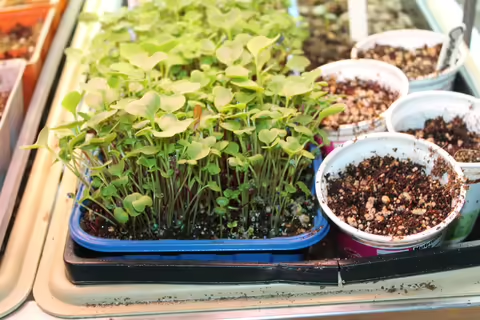URBANA, Ill. – With winter upon us, gardeners may be looking for a new project to keep their green thumbs active.
“Growing microgreens indoors is a fun and relatively easy project to set up,” says Austin Little, University of Illinois Extension horticulture educator. “It also rewards the grower with fresh, tasty produce in a short time period.”
Microgreens are the tender new shoots of vegetable plants, which are harvested before they reach maturity.
The basic supplies to get started with microgreens are a shallow container with drainage, such as a plastic tray or pie tin. Takeout containers can even work, just remember to add holes in the bottom for drainage. The rest of the supplies include vegetable seeds, growing medium, a light source, and plant food.
“That’s really all you need to get a tray or two of microgreens started this winter,” says Little. “Although many enthusiastic hobbyists upgrade, with some even starting successful microgreen businesses in their homes.”
Many vegetables can be grown for microgreens including mustard, kale, endive, arugula, beets, radish, watercress, peas, cabbage, basil, and most kinds of lettuce. Plants in the Solanaceous or nightshade family, which includes tomatoes, eggplants, and peppers, should not be grown as microgreens due to toxins in the stems and foliage.
Once seeds have been selected, the next step is to add the growing medium. The easiest way to get started is with a store-bought, pre-made potting mix, or soil mixed with compost, added to the container about 2 inches deep.
Since the shoots are harvested while they are immature, seeds need to be planted densely, about a ¼ inch apart, or less. After broadcasting a layer of seed, spread an additional thin layer of medium over the top to cover the seed and press down lightly to secure the seeds.
Water the soil so it is moist, but not sopping wet. Some growers pre-moisten the medium before planting and then water a bit more after. Microgreens generally don’t require much added fertility, but it may help to include a small amount of water-soluble fertilizer, or root-stimulating nutrient solution with the first watering. Rates for these fertilizers are low, around one teaspoon per gallon of water.
Check the container daily to make sure the medium stays moist. Spray the medium once or twice a day, or bottom water the container. By placing the growing container in a tray with a shallow layer of water, it can slowly take up water over several days.
Microgreens need about six to eight hours of light per day for optimal growth. A sunny, south-facing window is preferred. Alternatively, LED grow lights can provide the needed light. Also, keep the temperature in mind. Microgreens grow best around 70° F, but will tolerate down to 50° F, although growing will be slower. A seed-starting heat mat can be used if temperatures are low.
Microgreens are ready to harvest in about 10 to 12 weeks. Take up the whole plant with the roots or cut them at the base with sharp scissors. In both cases, they need to be submerged in cold water and rinsed thoroughly. The greens can be harvested all at once and stored in the fridge, or harvested as needed.
“Compared to their full-grown versions, microgreens offer unique flavors,” Little says. “After a quick wash, you can add them to salad, or a stir-fry and on top of soups and sandwiches for a fresh crunch.”
For further instructions, Illinois Extension has a recorded webinar on growing microgreens available at go.illinois.edu/MicroWebinar.
SOURCE: Austin Little, Horticulture Educator, Illinois Extension
ABOUT EXTENSION: Illinois Extension leads public outreach for University of Illinois by translating research into action plans that allow Illinois families, businesses, and community leaders to solve problems, make informed decisions, and adapt to changes and opportunities.
PHOTO ACCESS: available to download for media use.
